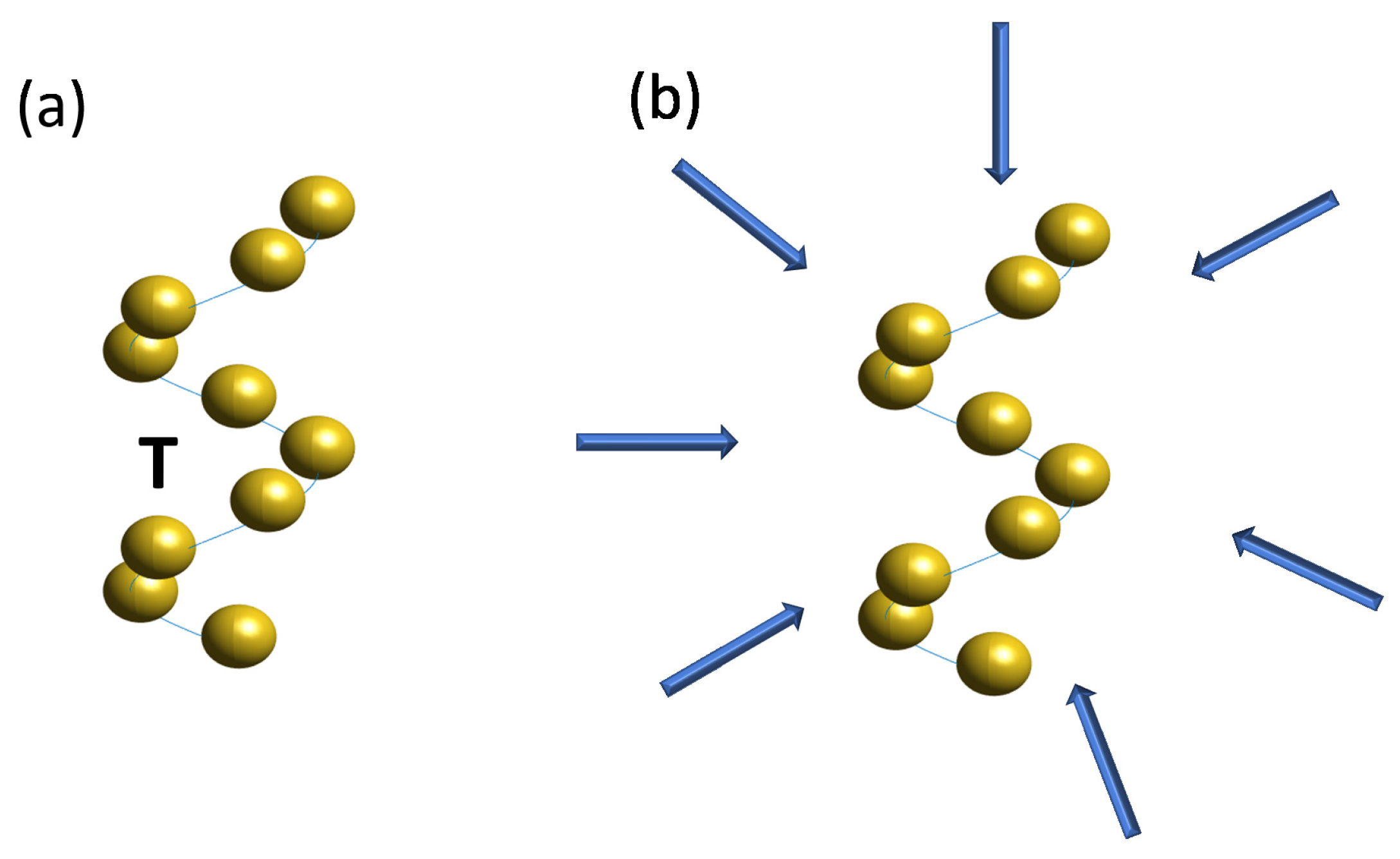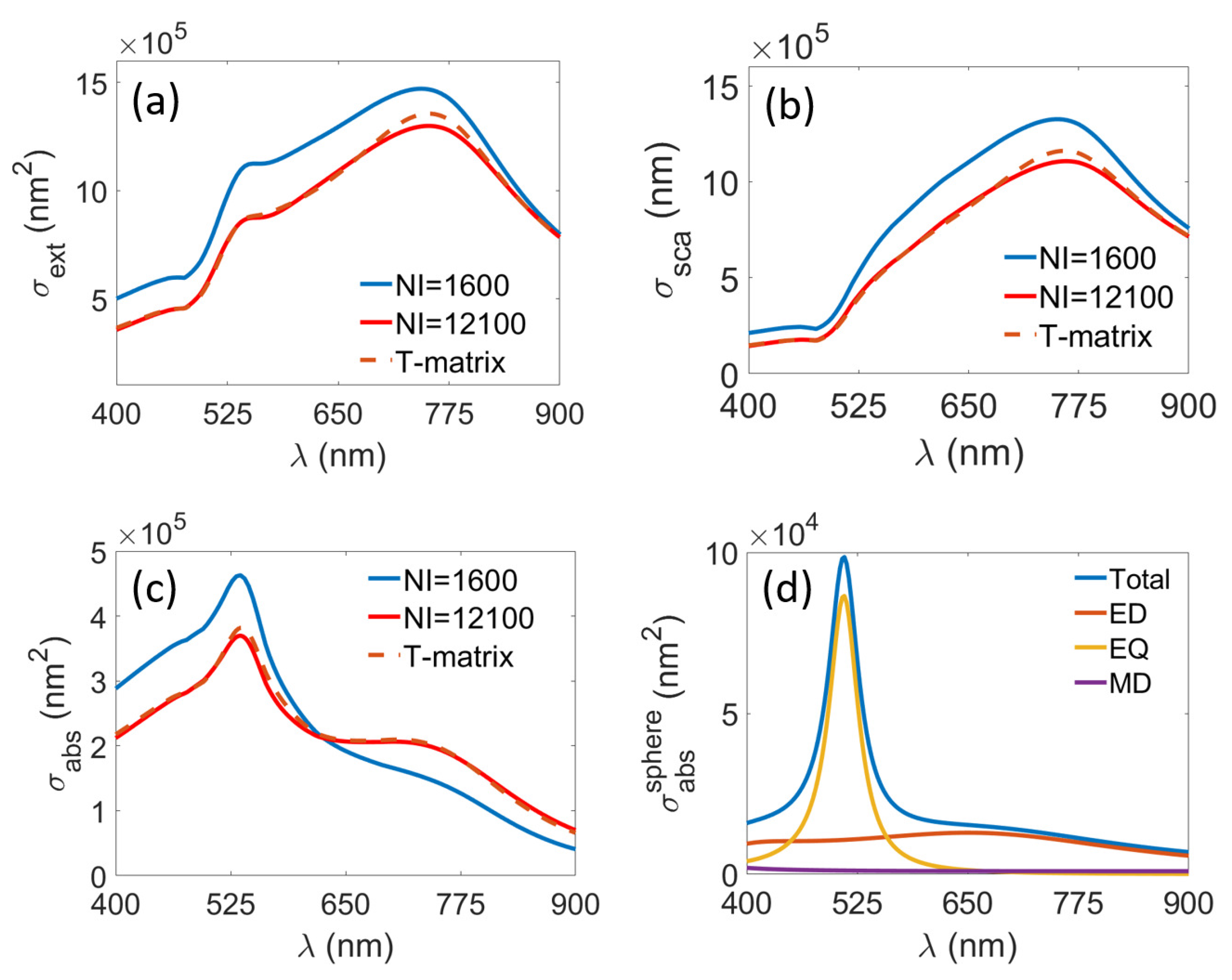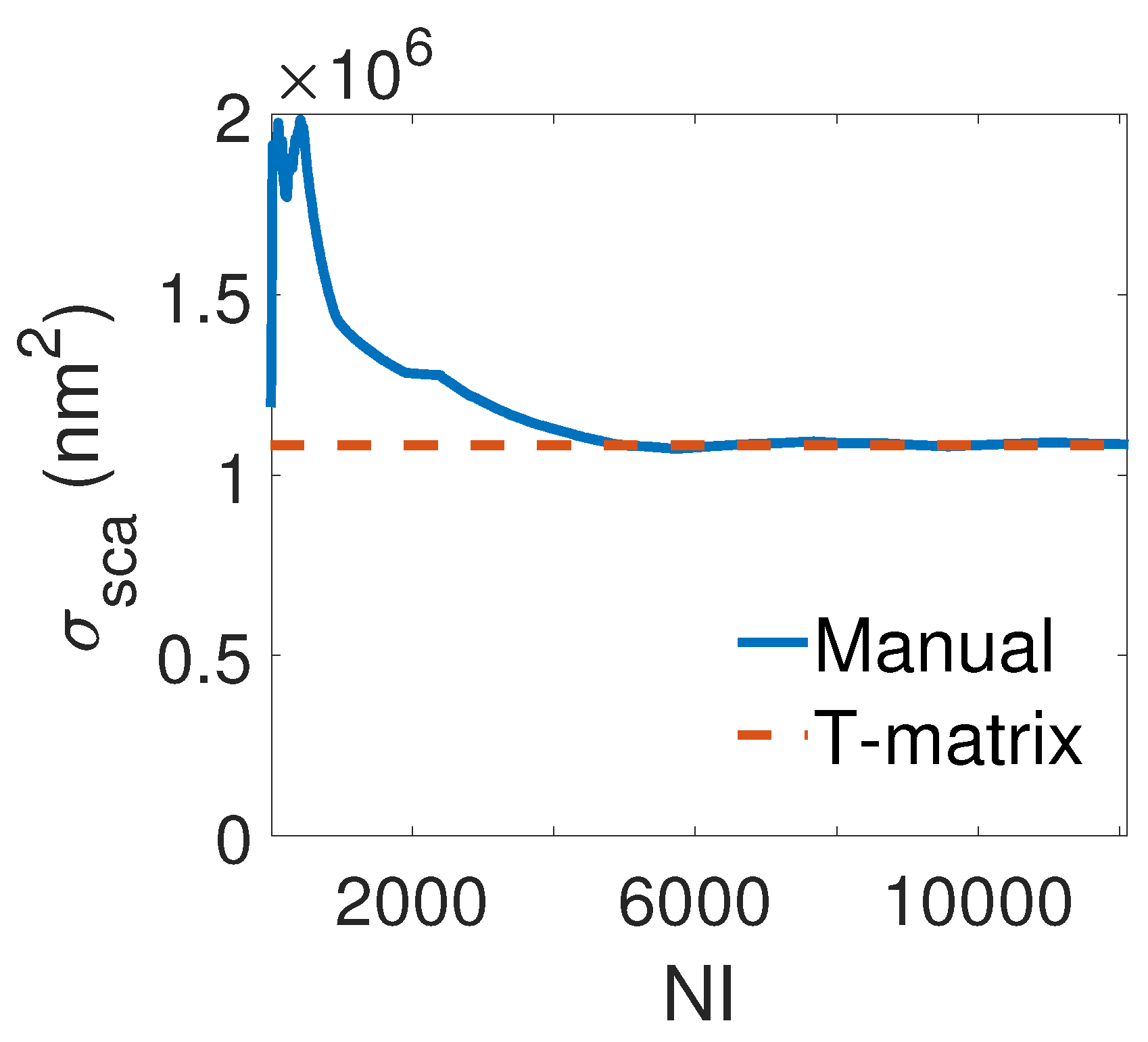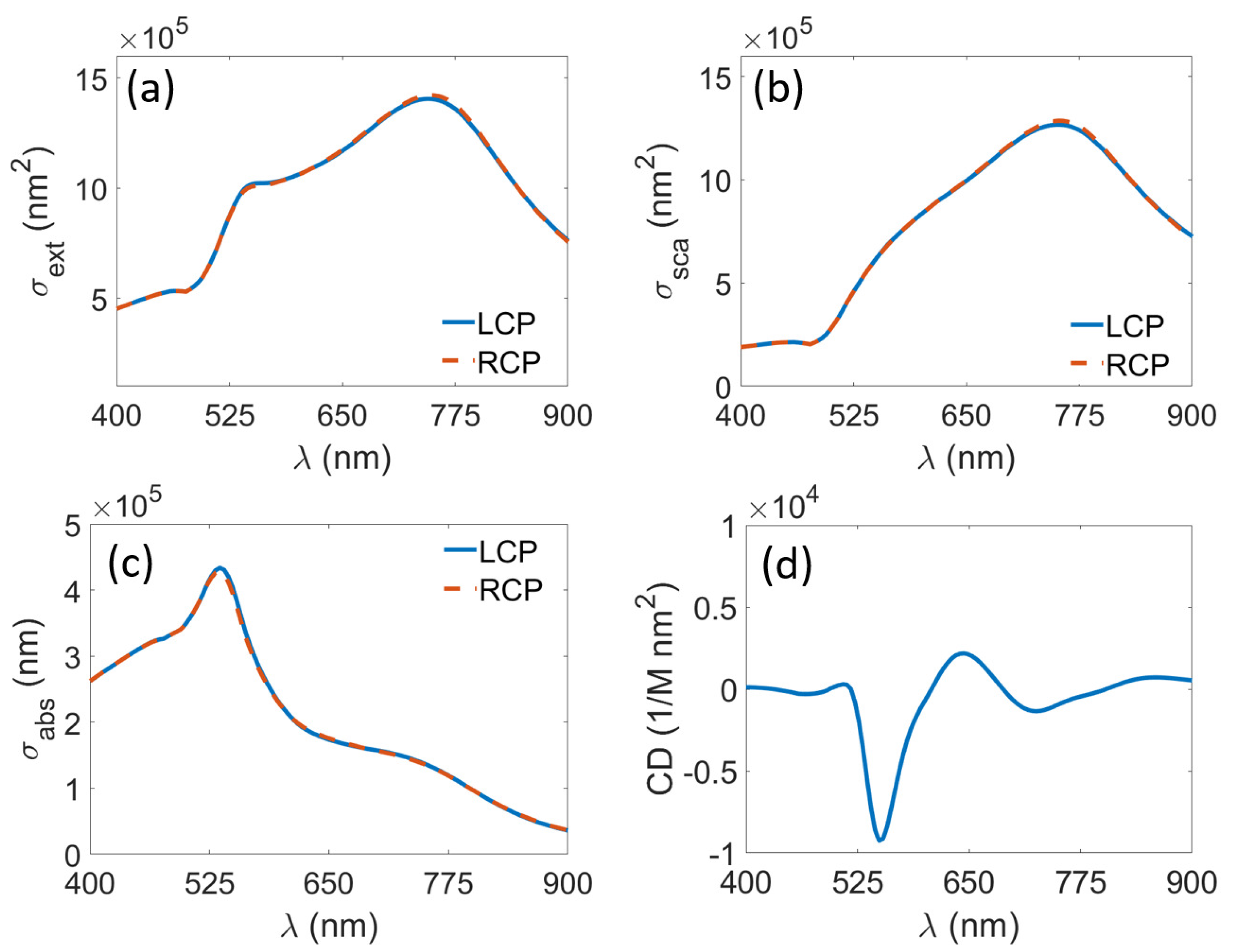Predicting Observable Quantities of Self-Assembled Metamaterials from the T-Matrix of Its Constituting Meta-Atom
Abstract
:1. Introduction
2. T-Matrix Formalism
3. Predicting Observable Quantities from the T-Matrix of Individual Meta-Atoms
4. Results
5. Conclusions
Acknowledgments
Author Contributions
Conflicts of Interest
References
- Pendry, J.B. Negative refraction makes a perfect lens. Phys. Rev. Lett. 2000, 85, 3966–3969. [Google Scholar] [CrossRef] [PubMed]
- Shelby, R.A.; Smith, D.R.; Schultz, S. Experimental verification of a negative index of refraction. Science 2001, 292, 77–79. [Google Scholar] [CrossRef] [PubMed]
- Linden, S.; Enkrich, C.; Wegener, M.; Zhou, J.; Koschny, T.; Soukoulis, C.M. Magnetic response of metamaterials at 100 terahertz. Science 2004, 306, 1351–1353. [Google Scholar] [CrossRef] [PubMed]
- Schurig, D.; Mock, J.J.; Justice, B.J.; Cummer, S.A.; Pendry, J.B.; Starr, A.F.; Smith, D.R. Metamaterial electromagnetic cloak at microwave frequencies. Science 2006, 314, 977–980. [Google Scholar] [CrossRef] [PubMed]
- Urbas, A.M.; Jacob, Z.; Negro, L.D.; Engheta, N.; Boardman, A.D.; Egan, P.; Khanikaev, A.B.; Menon, V.; Ferrera, M.; Kinsey, N.; et al. Roadmap on optical metamaterials. J. Opt. 2016, 18, 093005. [Google Scholar] [CrossRef]
- Tretyakov, S.A. Complex-media electromagnetics and metamaterials. J. Opt. 2017, 19. [Google Scholar] [CrossRef]
- Simovski, C.; Tretyakov, S. Model of isotropic resonant magnetism in the visible range based on core-shell clusters. Phys. Rev. B 2009, 79, 045111. [Google Scholar] [CrossRef]
- Marcos, J.S.; Silveirinha, M.G.; Engheta, N. μ-near-zero supercoupling. Phys. Rev. B 2015, 91, 195112. [Google Scholar] [CrossRef]
- Gómez-Graña, S.; Le Beulze, A.; Treguer-Delapierre, M.; Mornet, S.; Duguet, E.; Grana, E.; Cloutet, E.; Hadziioannou, G.; Leng, J.; Salmon, J.B.; et al. Hierarchical self-assembly of a bulk metamaterial enables isotropic magnetic permeability at optical frequencies. Mater. Horiz. 2016, 3, 596–601. [Google Scholar] [CrossRef]
- Zambrana-Puyalto, X.; Fernandez-Corbaton, I.; Juan, M.; Vidal, X.; Molina-Terriza, G. Duality symmetry and Kerker conditions. Opt. Lett. 2013, 38, 1857–1859. [Google Scholar] [CrossRef] [PubMed]
- Lovera, A.; Gallinet, B.; Nordlander, P.; Martin, O.J. Mechanisms of Fano resonances in coupled plasmonic systems. ACS Nano 2013, 7, 4527–4536. [Google Scholar] [CrossRef] [PubMed]
- Singham, S.B. Coupled dipoles in light scattering by randomly oriented chiral particles. J. Chem. Phys. 1988, 88, 1522–1527. [Google Scholar] [CrossRef]
- Schäferling, M. Chiral Nanophotonics: Chiral Optical Properties of Plasmonic Systems; Springer: New York, NY, USA, 2016; Volume 205. [Google Scholar]
- Lindell, I.V.; Sihvola, A.; Yla-Oijala, P.; Wallén, H. Zero backscattering from self-dual objects of finite size. IEEE Trans. Antennas Propag. 2009, 57, 2725–2731. [Google Scholar] [CrossRef]
- Barron, L.D. Molecular Light Scattering and Optical Activity; Cambridge University Press: Cambridge, MA, USA, 2004. [Google Scholar]
- Deubel, M.; Von Freymann, G.; Wegener, M.; Pereira, S.; Busch, K.; Soukoulis, C.M. Direct laser writing of three-dimensional photonic-crystal templates for telecommunications. Nat. Mater. 2004, 3, 444–447. [Google Scholar] [CrossRef] [PubMed]
- Wu, W.; Yu, Z.; Wang, S.Y.; Williams, R.S.; Liu, Y.; Sun, C.; Zhang, X.; Kim, E.; Shen, Y.R.; Fang, N.X. Midinfrared metamaterials fabricated by nanoimprint lithography. Appl. Phys. Lett. 2007, 90, 063107. [Google Scholar] [CrossRef]
- Rill, M.S.; Plet, C.; Thiel, M.; Staude, I.; Von Freymann, G.; Linden, S.; Wegener, M. Photonic metamaterials by direct laser writing and silver chemical vapour deposition. Nat. Mater. 2008, 7, 543–546. [Google Scholar] [CrossRef] [PubMed]
- Boltasseva, A.; Shalaev, V.M. Fabrication of optical negative-index metamaterials: Recent advances and outlook. Metamaterials 2008, 2, 1–17. [Google Scholar] [CrossRef]
- Chen, Z.; Zhan, P.; Wang, Z.; Zhang, J.; Zhang, W.; Ming, N.; Chan, C.T.; Sheng, P. Two-and Three-Dimensional Ordered Structures of Hollow Silver Spheres Prepared by Colloidal Crystal Templating. Adv. Mater. 2004, 16, 417–422. [Google Scholar] [CrossRef]
- Galisteo, J.; García-Santamaría, F.; Golmayo, D.; Juarez, B.; Lopez, C.; Palacios, E. Self-assembly approach to optical metamaterials. J. Opt. A Pure Appl. Opt. 2005, 7, S244–S254. [Google Scholar] [CrossRef]
- Gwo, S.; Lin, M.H.; He, C.L.; Chen, H.Y.; Teranishi, T. Bottom-up Assembly of Colloidal Gold and Silver Nanostructures for Designable Plasmonic Structures and Metamaterials. Langmuir 2012, 28, 8902–8908. [Google Scholar] [CrossRef] [PubMed]
- Vignolini, S.; Yufa, N.A.; Cunha, P.S.; Guldin, S.; Rushkin, I.; Stefik, M.; Hur, K.; Wiesner, U.; Baumberg, J.J.; Steiner, U. A 3D Optical Metamaterial Made by Self-Assembly. Adv. Mater. 2012, 24, OP23–OP27. [Google Scholar] [CrossRef] [PubMed]
- Pawlak, D.A.; Turczynski, S.; Gajc, M.; Kolodziejak, K.; Diduszko, R.; Rozniatowski, K.; Smalc, J.; Vendik, I. How Far Are We from Making Metamaterials by Self-Organization? The Microstructure of Highly Anisotropic Particles with an SRR-Like Geometry. Adv. Funct. Mater. 2010, 20, 1116–1124. [Google Scholar] [CrossRef]
- Ponsinet, V.; Barois, P.; Gali, S.M.; Richetti, P.; Salmon, J.B.; Vallecchi, A.; Albani, M.; Le Beulze, A.; Gomez-Grana, S.; Duguet, E.; et al. Resonant isotropic optical magnetism of plasmonic nanoclusters in visible light. Phys. Rev. B 2015, 92, 220414. [Google Scholar] [CrossRef]
- Sadecka, K.; Berger, M.H.; Orlinski, K.; Jozwik, I.; Pawlak, D. Evolution of silver in a eutectic-based Bi2O3–Ag metamaterial. J. Mater. Sci. 2017, 52, 5503–5510. [Google Scholar] [CrossRef]
- Cross, G.H. Fundamental limit to the use of effective medium theories in optics. Opt. Lett. 2013, 38, 3057–3060. [Google Scholar] [CrossRef] [PubMed]
- Petersen, R.; Pedersen, T.G.; Gjerding, M.N.; Thygesen, K.S. Limitations of effective medium theory in multilayer graphite/hBN heterostructures. Phys. Rev. B 2016, 94, 035128. [Google Scholar] [CrossRef]
- Osipov, A.V.; Tretyakov, S.A. Modern Electromagnetic Scattering Theory with Applications; John Wiley & Sons: Hoboken, NJ, USA, 2017. [Google Scholar]
- Suryadharma, R.N.; Fruhnert, M.; Fernandez-Corbaton, I.; Rockstuhl, C. Studying plasmonic resonance modes of hierarchical self-assembled meta-atoms based on their transfer matrix. Phys. Rev. B 2017, 96, 045406. [Google Scholar] [CrossRef]
- Mühlig, S.; Menzel, C.; Rockstuhl, C.; Lederer, F. Multipole analysis of meta-atoms. Metamaterials 2011, 5, 64–73. [Google Scholar] [CrossRef]
- Fruhnert, M.; Fernandez-Corbaton, I.; Yannopapas, V.; Rockstuhl, C. Computing the T-matrix of a scattering object with multiple plane wave illuminations. Beilstein J. Nanotechnol. 2017, 8, 614–626. [Google Scholar] [CrossRef] [PubMed]
- Abdelrahman, M.I.; Rockstuhl, C.; Fernandez-Corbaton, I. Broadband suppression of backscattering at optical frequencies using low permittivity dielectric spheres. Sci. Rep. 2017, 7, 14762. [Google Scholar] [CrossRef] [PubMed]
- Fernandez-Corbaton, I.; Fruhnert, M.; Rockstuhl, C. Objects of maximum electromagnetic chirality. Phys. Rev. X 2016, 6, 031013. [Google Scholar] [CrossRef]
- Dintinger, J.; Mühlig, S.; Rockstuhl, C.; Scharf, T. A bottom-up approach to fabricate optical metamaterials by self-assembled metallic nanoparticles. Opt. Mater. Express 2012, 2, 269–278. [Google Scholar] [CrossRef]
- Mühlig, S.; Cunningham, A.; Dintinger, J.; Scharf, T.; Bürgi, T.; Lederer, F.; Rockstuhl, C. Self-assembled plasmonic metamaterials. Nanophotonics 2013, 2, 211–240. [Google Scholar] [CrossRef]
- Sihvola, A. Mixing rules with complex dielectric coefficients. Subsurf. Sens. Technol. Appl. 2000, 1, 393–415. [Google Scholar] [CrossRef]
- Fan, Z.; Govorov, A.O. Plasmonic circular dichroism of chiral metal nanoparticle assemblies. Nano Lett. 2010, 10, 2580–2587. [Google Scholar] [CrossRef] [PubMed]
- Kuzyk, A.; Schreiber, R.; Fan, Z.; Pardatscher, G.; Roller, E.M.; Högele, A.; Simmel, F.C.; Govorov, A.O.; Liedl, T. DNA-based self-assembly of chiral plasmonic nanostructures with tailored optical response. Nature 2012, 483, 311–314. [Google Scholar] [CrossRef] [PubMed]
- Bohren, C.F.; Huffman, D.R. Absorption and Scattering of Light by Small Particles; John Wiley & Sons: Hoboken, NJ, USA, 2008. [Google Scholar]
- Waterman, P.C. Matrix formulation of electromagnetic scattering. Proc. IEEE 1965, 53, 805–812. [Google Scholar] [CrossRef]
- Xu, Y.l. Electromagnetic scattering by an aggregate of spheres. Appl. Opt. 1995, 34, 4573–4588. [Google Scholar] [CrossRef] [PubMed]
- Johnson, P.B.; Christy, R.W. Optical constants of the noble metals. Phys. Rev. B 1972, 6, 4370. [Google Scholar] [CrossRef]




| No. | Name of Parameter | Expression for One Particular Illumination | Average Value |
|---|---|---|---|
| 1 | Scattering cross section | ||
| 2 | Extinction cross section | ||
| 3 | Absorption cross section |
| No | Parameter | Average Value |
|---|---|---|
| 1 | Scattering cross section (LCP) | |
| 2 | Extinction cross section (LCP) | |
| 3 | Absorption cross section (LCP) | |
| 4 | Scattering cross section (RCP) | |
| 5 | Extinction cross section (RCP) | |
| 6 | Absorption cross section (RCP) | |
| 7 | Circular Dichroism |
© 2018 by the authors. Licensee MDPI, Basel, Switzerland. This article is an open access article distributed under the terms and conditions of the Creative Commons Attribution (CC BY) license (http://creativecommons.org/licenses/by/4.0/).
Share and Cite
Suryadharma, R.N.S.; Rockstuhl, C. Predicting Observable Quantities of Self-Assembled Metamaterials from the T-Matrix of Its Constituting Meta-Atom. Materials 2018, 11, 213. https://doi.org/10.3390/ma11020213
Suryadharma RNS, Rockstuhl C. Predicting Observable Quantities of Self-Assembled Metamaterials from the T-Matrix of Its Constituting Meta-Atom. Materials. 2018; 11(2):213. https://doi.org/10.3390/ma11020213
Chicago/Turabian StyleSuryadharma, Radius N. S., and Carsten Rockstuhl. 2018. "Predicting Observable Quantities of Self-Assembled Metamaterials from the T-Matrix of Its Constituting Meta-Atom" Materials 11, no. 2: 213. https://doi.org/10.3390/ma11020213





